功能对等理论指导下的产品说明书的翻译——基于iPhone使用指南案例研究
功能对等理论视域下的英语翻译探究
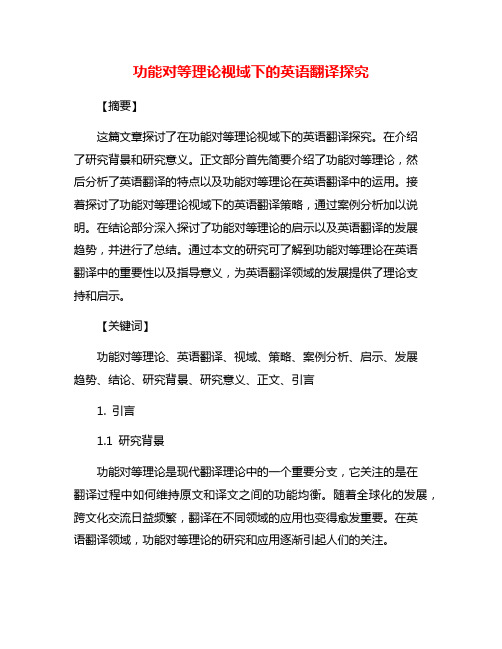
功能对等理论视域下的英语翻译探究【摘要】这篇文章探讨了在功能对等理论视域下的英语翻译探究。
在介绍了研究背景和研究意义。
正文部分首先简要介绍了功能对等理论,然后分析了英语翻译的特点以及功能对等理论在英语翻译中的运用。
接着探讨了功能对等理论视域下的英语翻译策略,通过案例分析加以说明。
在结论部分深入探讨了功能对等理论的启示以及英语翻译的发展趋势,并进行了总结。
通过本文的研究可了解到功能对等理论在英语翻译中的重要性以及指导意义,为英语翻译领域的发展提供了理论支持和启示。
【关键词】功能对等理论、英语翻译、视域、策略、案例分析、启示、发展趋势、结论、研究背景、研究意义、正文、引言1. 引言1.1 研究背景功能对等理论是现代翻译理论中的一个重要分支,它关注的是在翻译过程中如何维持原文和译文之间的功能均衡。
随着全球化的发展,跨文化交流日益频繁,翻译在不同领域的应用也变得愈发重要。
在英语翻译领域,功能对等理论的研究和应用逐渐引起人们的关注。
功能对等理论的提出源于翻译活动不仅仅是语言转换,更重要的是传递信息和实现交际目的。
翻译不应只关注原文的语法结构和词汇,还应当注重译文的传达效果和交际功能。
在英语翻译中,传统的翻译方法往往只侧重于译文与原文之间的语言表面现象,而功能对等理论则强调应该同时关注语言形式和实际意义的传达。
随着功能对等理论在翻译领域的不断深入研究和应用,我们可以更好地理解英语翻译的特点、规律和难点。
本文旨在探讨功能对等理论视域下的英语翻译方法和策略,为提高英语翻译质量和效率提供新的思路和方法。
1.2 研究意义The significance of exploring English translation from the perspective of functional equivalence theory lies in its potential to enhance the quality and effectiveness of translations. By understanding the principles of functional equivalence theory and applying them to English translation, translators can produce more accurate and culturally appropriate translations that better convey the intended message of the source text. This not only benefits the target audience by providing them with a clearer understanding of the text, but also helps to preserve the integrity of the original content. Additionally, studying English translation through the lens of functional equivalence theory can contribute to the advancement of translation studies as a whole,providing valuable insights into the intricate process of translation and opening up new avenues for research and exploration in the field. Ultimately, this research can have a positive impact on the translation industry by promoting higher standards of translation practice and fostering greatercross-cultural communication and understanding.2. 正文2.1 功能对等理论简介功能对等理论是翻译研究领域中的一种重要理论范式,其核心思想是在翻译过程中实现原文与译文的功能对等。
功能对等理论指导下的学术英语翻译
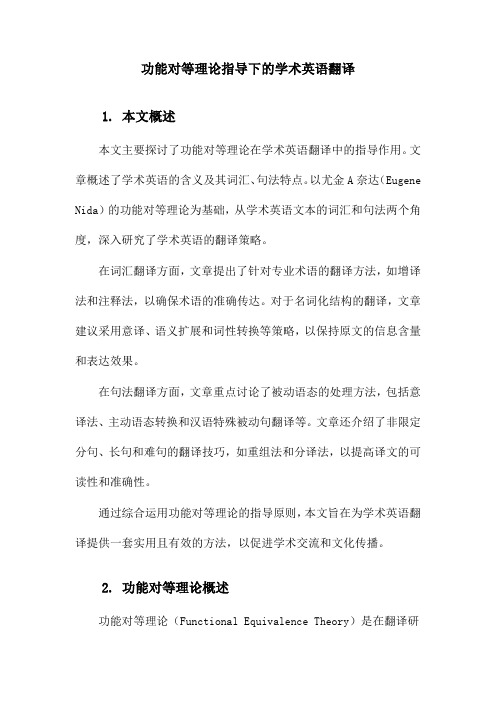
功能对等理论指导下的学术英语翻译1. 本文概述本文主要探讨了功能对等理论在学术英语翻译中的指导作用。
文章概述了学术英语的含义及其词汇、句法特点。
以尤金A奈达(Eugene Nida)的功能对等理论为基础,从学术英语文本的词汇和句法两个角度,深入研究了学术英语的翻译策略。
在词汇翻译方面,文章提出了针对专业术语的翻译方法,如增译法和注释法,以确保术语的准确传达。
对于名词化结构的翻译,文章建议采用意译、语义扩展和词性转换等策略,以保持原文的信息含量和表达效果。
在句法翻译方面,文章重点讨论了被动语态的处理方法,包括意译法、主动语态转换和汉语特殊被动句翻译等。
文章还介绍了非限定分句、长句和难句的翻译技巧,如重组法和分译法,以提高译文的可读性和准确性。
通过综合运用功能对等理论的指导原则,本文旨在为学术英语翻译提供一套实用且有效的方法,以促进学术交流和文化传播。
2. 功能对等理论概述功能对等理论(Functional Equivalence Theory)是在翻译研究领域中具有深远影响的一种理念,由美国翻译理论家尤金奈达(Eugene A. Nida)于20世纪50年代提出。
该理论强调在翻译过程中不仅要关注原文的形式和词汇层面的对应,更要追求源语与译入语之间的意义和功能上的对等。
奈达认为,理想的翻译应当使目标语言读者在阅读译文时能获得与原文读者阅读原文时相同或相近的理解效果和反应。
功能对等理论的核心原则是动态对等(Dynamic Equivalence),它要求译者在保留原文信息内容的同时,充分考虑文化背景、语境以及接受者的认知习惯等因素,力求在目的语中找到最自然、最贴切的表达方式,使译文既忠实于原文的精神实质,又符合目的语的语言规范和社会交际习惯。
具体来说,在学术英语翻译中,功能对等理论倡导的是深入理解原文的学术概念、逻辑结构和论证方式,并在此基础上寻找能够准确传递这些复杂内涵且易于目标语言读者接受的翻译策略。
从关联理论的视角分析科技翻译中的全译与变译
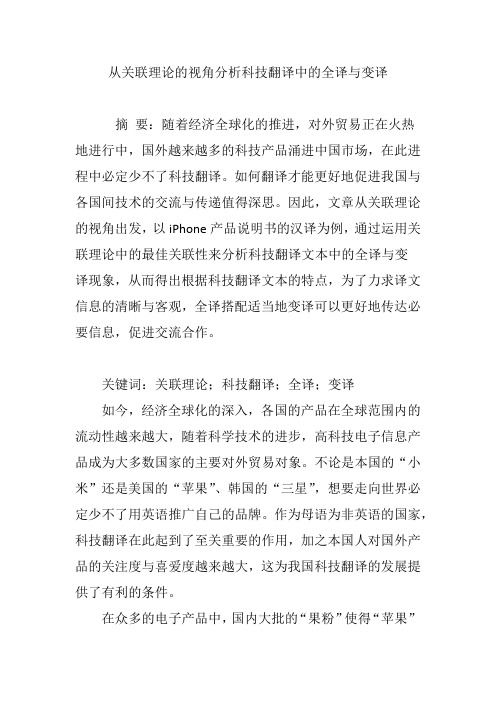
从关联理论的视角分析科技翻译中的全译与变译摘要:随着经济全球化的推进,对外贸易正在火热地进行中,国外越来越多的科技产品涌进中国市场,在此进程中必定少不了科技翻译。
如何翻译才能更好地促进我国与各国间技术的交流与传递值得深思。
因此,文章从关联理论的视角出发,以iPhone产品说明书的汉译为例,通过运用关联理论中的最佳关联性来分析科技翻译文本中的全译与变译现象,从而得出根据科技翻译文本的特点,为了力求译文信息的清晰与客观,全译搭配适当地变译可以更好地传达必要信息,促进交流合作。
关键词:关联理论;科技翻译;全译;变译如今,经济全球化的深入,各国的产品在全球范围内的流动性越来越大,随着科学技术的进步,高科技电子信息产品成为大多数国家的主要对外贸易对象。
不论是本国的“小米”还是美国的“苹果”、韩国的“三星”,想要走向世界必定少不了用英语推广自己的品牌。
作为母语为非英语的国家,科技翻译在此起到了至关重要的作用,加之本国人对国外产品的关注度与喜爱度越来越大,这为我国科技翻译的发展提供了有利的条件。
在众多的电子产品中,国内大批的“果粉”使得“苹果”一举成为关注度最高的品牌,它产品形式的多样化,产品更新换代的快速化为国内翻译人员提供了大量的翻译素材。
科技翻译与其他翻译形式一样,都有其自身的特点,本文以“苹果”手机说明书的汉译本为例,通过运用关联理论分析译者是怎样将全译与变译相结合以达到译文在语义与语用上的最佳关联,从而达到最佳的交际效果。
一、理论依据(一)关联理论与翻译关联理论(Relevance Theory)是法国学者斯波伯(Sperber)英国学者威尔逊(Wilson)在1986年合著的专著《关联性:交际与认知》中提出的。
此理论的提出被认为是西方近年来影响很大的认知语用学理论,并且其影响现今已远远超出了语用学领域[1]。
自关联理论提出之后,国内外很多专著与文章对其进行了研究,国外的语言学刊物如Lingua曾出过两期关于认知语用研究成果的专题报道,其中包括“关联理论中的关联”、“关联与指称”、“关联的语法制约”、“关联与会话”等[2]。
功能对等理论在英语翻译中的应用研究
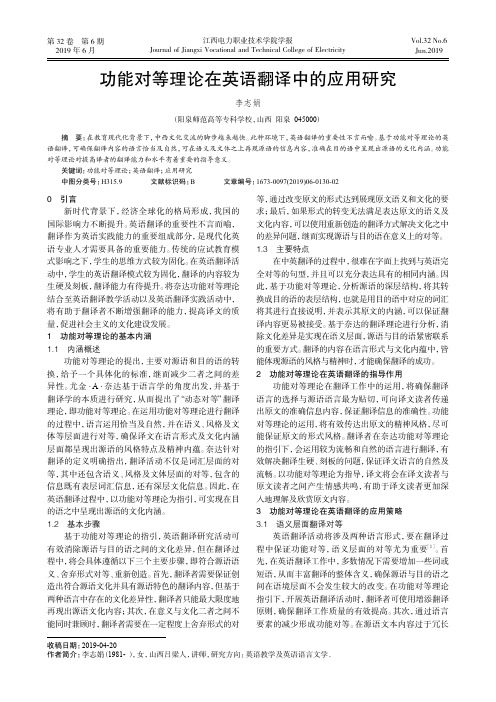
第 32 卷 第 6 期2019 年 6 月江西电力职业技术学院学报Journal of Jiangxi Vocational and Technical College of ElectricityVol.32 No.6Jun.2019功能对等理论在英语翻译中的应用研究李志娟(阳泉师范高等专科学校,山西阳泉 045000)摘 要:在教育现代化背景下,中西文化交流的脚步越来越快。
此种环境下,英语翻译的重要性不言而喻。
基于功能对等理论的英语翻译,可确保翻译内容的语言恰当及自然,可在语义及文体之上再现源语的信息内容,准确在目的语中呈现出源语的文化内涵。
功能对等理论对提高译者的翻译能力和水平有着重要的指导意义。
关键词:功能对等理论;英语翻译;应用研究中图分类号:H315.9 文献标识码:B 文章编号:1673-0097(2019)06-0130-020 引言新时代背景下,经济全球化的格局形成,我国的国际影响力不断提升。
英语翻译的重要性不言而喻,翻译作为英语实践能力的重要组成部分,是现代化英语专业人才需要具备的重要能力。
传统的应试教育模式影响之下,学生的思维方式较为固化。
在英语翻译活动中,学生的英语翻译模式较为固化,翻译的内容较为生硬及刻板,翻译能力有待提升。
将奈达功能对等理论结合至英语翻译教学活动以及英语翻译实践活动中,将有助于翻译者不断增强翻译的能力,提高译文的质量,促进社会主义的文化建设发展。
1 功能对等理论的基本内涵1.1 内涵概述功能对等理论的提出,主要对源语和目的语的转换,给予一个具体化的标准,继而减少二者之间的差异性。
尤金·A·奈达基于语言学的角度出发,并基于翻译学的本质进行研究,从而提出了“动态对等”翻译理论,即功能对等理论。
在运用功能对等理论进行翻译的过程中,语言运用恰当及自然,并在语义、风格及文体等层面进行对等,确保译文在语言形式及文化内涵层面都呈现出源语的风格特点及精神内蕴。
浅谈功能对等理论在科技英语翻译中的应用

山东农业工程学院学报2019年第36卷第2期20世纪中期世界各国之间的频繁往来,促进了经济、文化、科学的快速发展。
其中科学技术的研究与交流已经成为主流。
由于我国与世界的友好的往来,国外的科学技术已经进入国内。
英语作为与国外主要交流语言,科技英语翻译的出现,使我国对待科技英语的翻译工作十分看重,我国科学技术水平的提高,大量的科技文献需要翻译工作者去完成,因此在科技英语的翻译中应用功能对等理论法,以准确实际的方法将科技进行规范英语翻译,从而使科技英语的翻译水平实现质的飞跃。
1.功能对等理论与科技英语的特点1.1功能对等理论功能对等理论,主要是指在翻译时做到对照原文的语法与词汇,在不改变原文意思的情况下,做到一一对等。
而功能对等理论法来自奈达与他人共同写的一本书中。
功能对等理论出现的时候,世界科学技术的创新与发展正在快速兴起,科技英语受到越来越多的人们关注,从而使对等理论在英语翻译的使用中逐渐增多。
对等理论的兴起也是有一定的原因,此理论表达用最适合的方法将语意表达出来,强调阅读者与译文的关系,使读者能够明确原句表达的意义。
1.2科技英语的特点科技英语是英语的一种表现形式,其在自然科学与工程技术等相关论文、书籍中的应用的英语。
其中在自然科学上的使用较多,使科技英语已经成为一个独立的研究学科。
科技英语与其他种类的英语相比,其自身的特性比较突出。
1.2.1结构与词语修饰特点科技英语的使用类型大多都是议论文与说明文。
这类文体在语言表达上比较简明扼要,且内容真实可靠。
在科技文的表达中,被动语态经常出现,其目的是为了遵循理论实际,避免主观意识带来的片面影响。
为了能够清楚的表达原意,使文章的结构更明确,大多使用省略结构表达。
1.2.2语言特点科技英语的整篇语句在表达上,主要是能够保证信息的准确性,整体的结构具有逻辑性,最重要的是保证表达具有实际性。
在表达科学概念时,需要精准的语言,避免出现错误。
科技文的逻辑结构十分明浅谈功能对等理论在科技英语翻译中的应用王慧博(枣庄学院外国语学院山东枣庄277160)【摘要】我国经济与科技的迅猛发展正逐渐与世界接轨,在与国外交流学习的过程中,运用好科技英语,能够促进我国科学技术的发展。
交际翻译视角下苹果官网产品介绍两译本对比分析
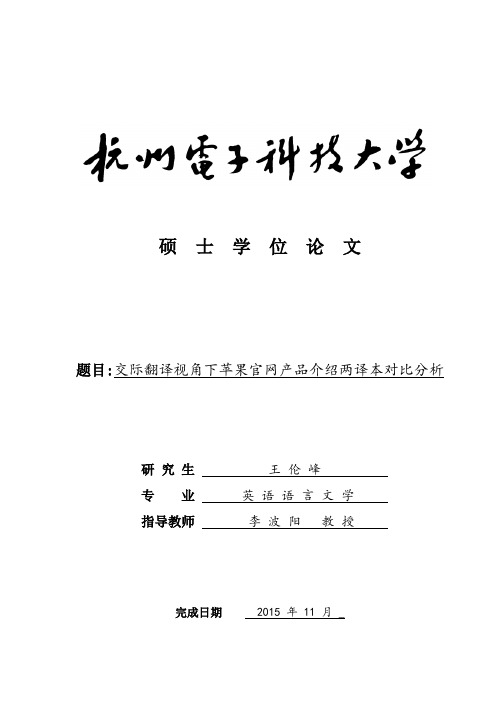
硕士学位论文题目:交际翻译视角下苹果官网产品介绍两译本对比分析研究生王伦峰专业英语语言文学指导教师李波阳教授完成日期2015年 11 月 _杭州电子科技大学学位论文原创性声明和使用授权说明原创性声明本人郑重声明:所呈交的学位论文,是本人在导师的指导下,独立进行研究工作所取得的成果。
除文中已经注明引用的内容外,本论文不含任何其他个人或集体已经发表或撰写过的作品或成果。
对本文的研究做出重要贡献的个人和集体,均已在文中以明确方式标明。
申请学位论文与资料若有不实之处,本人承担一切相关责任。
论文作者签名:日期:年月日学位论文使用授权说明本人完全了解杭州电子科技大学关于保留和使用学位论文的规定,即:研究生在校攻读学位期间论文工作的知识产权单位属杭州电子科技大学。
本人保证毕业离校后,发表论文或使用论文工作成果时署名单位仍然为杭州电子科技大学。
学校有权保留送交论文的复印件,允许查阅和借阅论文;学校可以公布论文的全部或部分内容,可以允许采用影印、缩印或其它复制手段保存论文。
(保密论文在解密后遵守此规定)论文作者签名:日期:年月日指导教师签名:日期:年月日杭州电子科技大学硕士学位论文交际翻译视角下苹果官网产品介绍两译本对比分析研究生:王伦峰指导教师:李波阳(教授)2015年11月Dissertation Submitted to Hangzhou Dianzi Universityfor the Degree of MasterOn the Two Translated Versions of Apple’s Product Introductions on Official Website from the Perspective of CommunicativeTranslation TheoryCandidate: Wang LunfengSupervisor: Prof. Li BoyangNovember, 2015摘要苹果公司的智能设备已成为个人终端市场的主流产品,而中国市场的消费能力已然对该公司的销售业绩起到了至关重要的支撑作用。
功能对等理论指导下的科技英语英汉翻译实践报告
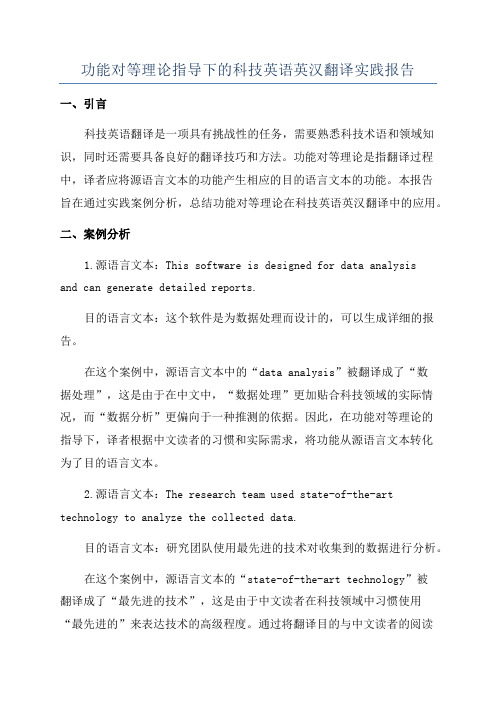
功能对等理论指导下的科技英语英汉翻译实践报告一、引言科技英语翻译是一项具有挑战性的任务,需要熟悉科技术语和领域知识,同时还需要具备良好的翻译技巧和方法。
功能对等理论是指翻译过程中,译者应将源语言文本的功能产生相应的目的语言文本的功能。
本报告旨在通过实践案例分析,总结功能对等理论在科技英语英汉翻译中的应用。
二、案例分析1.源语言文本:This software is designed for data analysisand can generate detailed reports.目的语言文本:这个软件是为数据处理而设计的,可以生成详细的报告。
在这个案例中,源语言文本中的“data analysis”被翻译成了“数据处理”,这是由于在中文中,“数据处理”更加贴合科技领域的实际情况,而“数据分析”更偏向于一种推测的依据。
因此,在功能对等理论的指导下,译者根据中文读者的习惯和实际需求,将功能从源语言文本转化为了目的语言文本。
2.源语言文本:The research team used state-of-the-art technology to analyze the collected data.目的语言文本:研究团队使用最先进的技术对收集到的数据进行分析。
在这个案例中,源语言文本的“state-of-the-art technology”被翻译成了“最先进的技术”,这是由于中文读者在科技领域中习惯使用“最先进的”来表达技术的高级程度。
通过将翻译目的与中文读者的阅读习惯相结合,译者将源语言文本的功能转化为了适合中文读者的目的语言文本。
三、案例总结功能对等理论在科技英语英汉翻译中的应用主要体现在两个方面:译者根据翻译目的和读者需求进行功能转化,以及根据目的语言的语言特点进行翻译。
在进行功能转化时,译者需要充分了解中文读者的习惯和实际需求,将源语言文本的功能转化为适合目的语言读者的功能。
例如,在第一个案例中,根据中文读者对数据处理的实际需求,译者将“data analysis”翻译为“数据处理”。
课 程 论 文 翻译 nida
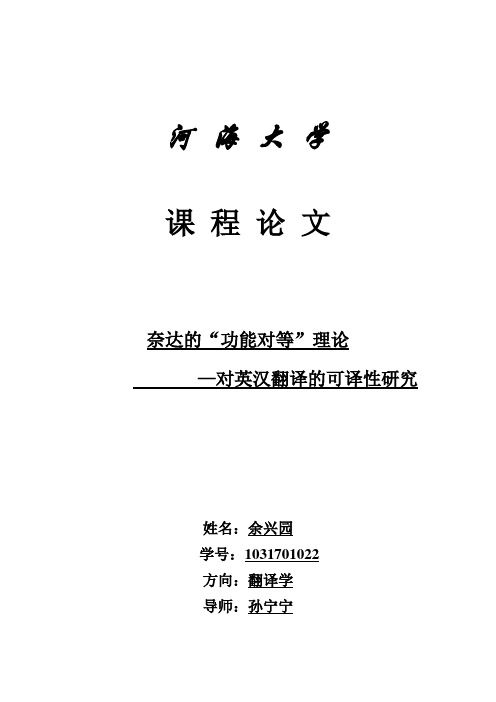
河海大学课程论文奈达的“功能对等”理论—对英汉翻译的可译性研究姓名:余兴园学号:1031701022方向:翻译学导师:孙宁宁HoHai UniversityThesis of Course of the Theory and Practice ofT ranslationFunctional Equivalence of Dr. Nid a—A Study on the Translatability inE—C TranslationBy YU XingyuanNO: 1031701022Supervisor: Prof. Sun Ningning内容摘要可译性及不可译性的问题一直是翻译界争论的话题。
随着翻译的发展,二者争论的焦点也不断由翻译的可能性转化为可译性的程度问题。
笔者认为文章在总体上是可译的。
可译性及不可译性只是一个相对的概念,没有绝对的不可译性。
可译性及不可译性事实上只是可译的程度问题。
美国著名的翻译家,语言学家尤金·奈达也是语言的共性论者,他坚持认为:一种语言所能表达的事情,必然能用另一种语言来表达。
尤其是二十世纪六十年代,他提出了“功能对等”理论,并以此为理论原则指导圣经翻译工作,翻译出更适合现代读者的圣经版本,为翻译的研究开辟了新的视野。
本文基于奈达的“功能对等”理论,对英汉翻译的可译性进行研究。
这项研究有助于更好的了解翻译的本质及一些翻译方法。
对于这些概念的了解会有助于指导翻译实践。
论文可以分为四个部分。
第一部分主要介绍了奈达及他的翻译理论;第二部分重点阐述了论文中翻译可译性的理论基础—“功能对等”;第三部分中笔者将理论转化为实践,探讨实践中可译程度较低的实例并找出其更好的可译性方法。
第四部分是论文的总结部分。
得出结论—文章在总体上是可译的,只是可译性程度高低问题;并以此提出译者的任务问题。
关键词:可译性;尤金·奈达;“功能对等”;译者的任务AbstractThe topic of translatability and untranslatability is a long-debated issue in translation field. Its history has accompanied the development of translation theory and practice. With the development of translation theory, the focus of the debate has shifted from the possibility of translation to the degree of the translatability. The study maintains that the writings are translatable as a whole. Translatability and untranslatability are relative concepts and there is no absolute translatability and untranslatability. The matter of translatability and untranslatability is actually the matter of the degree of translatability rather than the possibility of translation.Nida, a distinguished contemporary translation theorist and linguist in the west, is also a language universalist. In 1960’s he proposed a translation principle called “Dynamic(Functional) Equival ence” and guided his Bible translation works in the American Bible society. This version soon became popular in the world because of its clear, simple and natural language. Ni da’s translation theory exerted a tremendous influence on translation studies and boarded a new horizon on the studies of translation theory.The whole studies help us get more about the essence, the criteria and methods of translating which undoubtedly benefit our translation practice. The thesis includes four parts .The first part mainly introduces the life of Nida and his theory on translatability. The second part discusses translatability based on the criteria of “Functional Equivalence”. The third part shifts from the theory to the practice and find some ways to translate the low- degree translatability writings more perfectly. The last part of the thesis is the conclusion that translatability is absolute and the task of translator is also mentioned.Key W ords: translatability; Nida; “Functional Equivalence”; the task of translatorContents0.Introduction.........................................................................................................1. Nida and His Theory of Translatability to Translation. ...........1.1 Brief-introduction to Nida…………………………………1.2 Nida's Theory of Translatability to Translation………………2. The Criteria of Translating—Functional Equivalence …2.1 The Criteria of Translating……………………………………..2.2 The Development Steps of Functional Equivalence………………2.3 The Essence of Functional Equivalence…………………………..3. Application of the Criteria of Translating to Solve the Problems of Translating Practice ...................................................3.1 Pun…………………………………………………….3.2 Nonce Words………………………………………………….3.3 Word Play………………………………………………………..3.4 Word Riddle………………………………………………………3.5 Rhyming Scheme………………………………………………4. Conclusion ...................................................................................... Bibliography .......................................................................................0. IntroductionThe topic of translatability and untranslatability is a long-debated issue in translation field. Its history has accompanied the development of translation theory and practice. The early period of the debate is mainly focused on whether writings are translatable or untranslatable. As the central and basic issue in translation,it has attracted much attention and has aroused much interest in translation circles in China and abroad because of the many different opinions upon it. These opinions can be divided as two contrary sides: one supports translatability while the other favors untranslatability. Almost all the Translation scholars have proposed their opinions on this issue,whether for translatability or for untranslaiability.Lin Yutang in his On Translation once quoted Croce’s words“All the pure artistic works are untranslatable ,”and he also added“The top poems(especially the lyric poems) are untranslatable,be it Chinese or western,ancient or modern. The reason is that it is the load of the elite words of a specific language,and if it acts as the instinct connection between the authors’ ideals and words, the translation from,its original language to another one amounts to the loss of the Poem’s original taste,so the translation version can not be called as Poem.”(Zhou Yi. Luo Ping,1999:68) Wang Yizhu said in his Untranslaiability of Poems“frankly speaking,in my opinion,poems are untranslatable for the reason are simple: its taste,context or more popularly speaking,its flavor while makes a Poem is dissolved in the language Poets use to a large degree and it is difficult to convey through another language or dialect.”(Zhou Yi, Luo Ping,1999:69).To sum up the opinions of preceding scholars,we can find something in common in their opinion s—some writings are untranslatable such as poems,1iterary style and some rhetorical forms.The theorists who favor the view of translatability say the opposite. They think writings are translatable,even those such as poems,literary style and specific rhetorical forms that are considered as untranslatable by theorists favoring untranslatability. For the untranslatability of poems, Cheng Fangwu once opposed as “translation of poems is not an impossible task, according to my experience,some poems firstly seeming difficult to translate can also be completely translated through deep consideration. Therefore the translatability of poems depend on the translating ability and efforts. Something that is expressed in language of one country can always be translated into that of another country by using some proper methods.” (Zhou Yi. Luo Ping, 1998:70).For the untranslatability of special rhetorical forms Xu Yuanchong Said “even the context of allusion or pun are not absolutely untranslatable if methods aresuitable.” (Zhou Yi. Luo Ping,1999:71).Of all the views of translatability in abroad,Nida proposed the most typical one from the point of internal structure of Language. Through a detailed study of the nature of meaning Nida founds that language can prove to be an adequate tool to express all and any aspects of human experience. It is a fact that the mapping of experience by language is limited to specific cultures and People do not talk about things of which they are no aware,however,when some Part of their experience arises forma level to an overt level,they are able to speak it just as can describe new objects that enter into their experience. (Nida, 1964:50) This gives us that the language has the potential to describe new objects and concepts that arise in the evolution of their experience and concepts that come from other culture. This paves up the foundation of translatability rather than untranslatability.With the development of the theory of translation studies, a growing number of theorists who have a more reasonable and complete views on the translatability and untranslatability is applied. First, translatability and untranslatability are relative concepts and there is no absolute translatability and untranslatability. The matter of translatability and untranslatability is actually the matter of the degree of translatability rather than the possibility of translation. Second, with the globalization of the world, translatability is the main trend.As mentioned above, we should grape more about the essence, the criteria and methods of translating that will guide our practice more perfectly. I hope this study will help us know more about translation theory and grope a new respect on translation practice.1. Nida and His Theory of Translatability to TranslationEugene A. Nida, a distinguished American translation theorist and translator whose important position in the study of translation is established in the1960s, influences the whole western translation theory field. His translation theory began to be introduced into China in the early 1980s and quickly accepted by many Chinese translators and Chinese translation theorists.From1945 to 1997,he authored or co-authored more than 40 books and 250 articles on linguistics, semantics and translation. He is praised as the ever-green scholar by translators and critics.1.1Brief-introduction to NidaNida,Eugene Albert Nida in full, was born on November 11, 1914, in Oklahoma City of the U.S. His family moved to Long Beach, California when he was 5 years old. He began studying Latin in high school and was already looking forward to being able to translate scripture as a missionary. By the time he received his Bachelor degree in 1936 from the University of California at Los Angeles, he was well on his way. Having earned his degree in Greek, summa cum laude, he enrolled in the Summer Institute of Linguistics (SIL). Nida then pursued a Master's degree in Greek New Testament at the University of Southern California. In 1941 he began a Ph.D. in Linguistics at the University of Michigan and completed it in two years. His dissertation, A Synopsis of English Syntax under the academic guidance of the distinguished Professors Charles C. Fries,Leonard Bloomfield and Edgar H. Sturtevant,was at that time, the only full-scale analysis of a major language according to the “immediate constituent” theory.After Nida got his Ph.D. in linguistics,he was soon employed in1943 by the American Bible Society to check and value the publication of Bibles. He actively took part in academic research concerning translation theory and modern linguistics. Then he was determined to produce a theory that would foster effective communication of the Good News across all kinds of cultural and linguistics barriers. His book Toward a Science of Translating (1964),and later The Theory and Practice of Translation (1969) helped him achieve this object. Nida has exerted great influence on modern linguistics and translation theory. We will discuss one of his most important theory on translation—Functional Equivalence on Chapter Two in detail.1.2Nida's Theory of Translatability to TranslationIn the history of translation theory, one of the central problems is the question of translatability and untranslatability of a text. Nida states that anything said in one language can be said in another.Through a detailed study of the nature of meaning,Nida finds that language can prove to be an adequate tool to express all and any aspects of human experience. It is a fact that the mapping of experience by language is limited to specific cultures and people do not talk about things of which they are not ware.However,when some of their experience arises from a covert lever an overtlevel,they are able to speak it just as they can describe new objects that enter into their experience(Nida,1964:50).This means that any language has the potential to describe new objects and concepts that come from other cultures.Nida’s translatability theory is based upon his two premises:the freedom of languages as symbols and the existence of the universal human experience. To Nida,“Linguistic symbols are semantically free to expand,to contract,to shift their contents,to die,and to be revived. This freedom is of inestimable value,for only through such freedom can persons employ symbols in new combinations or use them to describe objects which are new to the experience of speech community”(Nida,1964:49) This freedom of symbols means not only that a language can be used to describe new objects which come into the culture,but also that a person can introduce new concept into a speech community by using verb symbols with certain contextual restrictions and amplifications.For Nida,what makes human communication possible is that all human beings share common cultural experience which transcends the seeming difference that exists between people speaking different language s and living in different cultural backgrounds. This universal human experience is the underlying base that makes human communication possible.Moreover, the freedom of language also enables it to express new concepts from other culture.Nida gives an example to illustrate how people who have no snow can understand a passage in the Bible that speaks about “white as snow”.If the people do not know snow,how can they have a word for it?And if they do not have a word for it,then how can the Bible be translated?Nida answers these questions as follows:In the first Place,many people have a word for snow,even if they have not themselves experienced it,for they have heard about this phenomenon. Secondly, in other instances,people do not know snow but they do have “frost”and they speak about the two with the same term. Thirdly, many languages have the same idioms, e.g., “white as egret feathers”or“white as fungus”or they may use a no metaphor to express the concept“white as snow”such as“very white”(Nida and Taber, 1982:4) This common or universal human experience is the crucial concept in Nida,translation theory.Nida’s concept of“universal”is pragmatic and functional which sees language in a larger context of culture.This kind of perspective enriches the traditional concept of universality of language,and offers new insights into the nature of translation. With this universal human experience,a high degree of effective translatability between languagesand cultures is made possible.2. The Criteria of Translating—Functional EquivalenceTo find the criteria of translating, we should know the definition of translation first. Translation may be defined as follows: the replacement of textual material in one language (SL.) by equivalent textual material in another language (TL.).”and “Translation consists in the reproduction in the receptor language of the source language understood the original message.”(Nida, 1985, quoted in Liu Miqing, 1990:33) According to Liu Miqing, in fact, the essence of translating is the interlingual transmission of meaning. To grape the meaning correctly, the criteria of translating is very important. Actually the criteria of translating are directly influenced by the understanding of the essence of translation and the methods using in translation practice.2.1 The Criteria of TranslatingChinese and western criteria focus respectively on the text and on the readship, though this division is not absolute. Many Chinese hold views of “Equivalence of Effects”, such as Ma Jianzhong, Qu Qiubai, Zhao Yuanren and Mao Dun.Among the criteria put forward by scholars at home and abroad, the famous ones in China are “Faithfulness, Intelligibility and Elegance”by Y an Fu. “Likeness in Spirit” by Fu Lei, “Sublimation” by Qian Zhongshu, etc. In the west, John Dryden’s idea of translating criteria is well known, and he regards: “I have endeavored to make Vigil speak such English as he would himself have spoken, if he had been born in England, and in this present age.”( Quoted in Bassnett·McGuir,1980:447). The most important famous one is “Functional Equivalence” by Nida.2.2 The Development Steps of Functional Equivalence“Translation Equivalence”has been an essential issue in modern western translation studies. The term “Equivalence”in translation first appears in Rieu’s writing, which was called “the principle of equivalent effect”.(Rieu 1953:554).Nida’s translation theory has been regarded as “equivalence theory”, “equivalent effect theory” or “functional equivalence” in China.Nida argued that there are two different types of equivalence, namely formal equivalence and dynamic equivalence, which later advanced to “functional equivalence”. We should know Nida first puts forward “dynamic equivalence”in opposition to “formal equivalence”in 1964. In 1990s, Nida said that the real issue was in defining the nature of equivalence, and stressed more than once that it was impossible to achieve absolute “‘equivalence’in translating.(Nida,1995). Later on, he said emphatically, “equivalence”can not be understood in its mathematical meaning of identity, but in terms of proximity, i.e. on the basis of degrees of closeness to functional identity”, then he proposed “functional equivalence”(Nida 1993:117).2.3 The Essence of Functional EquivalenceTo get complete understanding of the essence of “functional equivalence”, we should pay attention to the following points: first, Nida put forward “dynamic equivalence”in opposition to “formal equivalence”in the beginning. Second, “equivalence”in Nida’s theory never means absolute sameness. Third, “equivalence”can not be understood in its mathematical meaning of identity, but in terms of proximity.In translation theory, “formal equivalence”refers to translating by finding reasonably equivalent words and phrases while following the forms of the source language as closely as possible. It is often referred to as "literal translation." While Nida’s “functional equivalence”is a translation method in which the translator attempts to reflect the thought of the writer in the source language rather than the words and forms. The translator will read a sentence or other unit of thought, try to understand it as well as possible, and then write that thought in the target language. The forms of the source language are not important, because they are not the same as the forms of the target language.The theory of “functional equivalence” makes the point that the translator should make his audience understand the version in the original receptors to the original text. The acceptability of a version depends on the translator’s reproducing of the original functions. Ida generalizes language functions as: related to the source- expressive and cognitive functions; related to receptors-informative, imperative, performative and emotive; related to the source to receptor-interpersonal.(Nida, 1988:145).We know that translation practice is complicated. In order to come to achieve functional equivalence, methods of translating have to be pluralized according to various conditions. Nida points out that the two basic conflicts in translation history are literal vs. free translating and emphasis on form vs. concentration on content (Nida, 1986:74.).It also indicates the problem of literal translating or free translating. The two methods in fact have their own advantages and limitations. Methods of adaptation must be adopted flexibly according to the environment of each practical problem.Then we can use two methods in cooperation .All methods and adaptation are aiming at equivalence, and they should be flexibly adopted in accordance with each specific condition in practice. The next part can help you understand this part.3. Application of the Criteria of Translating to Solve theProblems of Translating Practice.This section includes two parts: first, list some problems in translating practice in E-C translation and its specific translation technique. Second, provide five basic principles in the solution to the problems deriving from specific translation technique.Since problems in practice of translation mainly from the unique feature in language and culture such as pun, nonce word, alliteration and word play etc.All these cases will be briefly introduced and some valuable techniques in translation are expected be found.3.1 PunPun refers to an amusing use of a word or phrase that has two meanings, or of word with the same sound but different meanings. For example “separate pear, separate pair”“分梨, 分离”fully shows the universals between languages.Pun can be divided into consonation pun and meaning pun.As their meaning indicate,the former refers to words of two meaning and the later refers to words of the same sound but different meanings. For meaning pun, the example is as follows:Romeo: What have thou found?Mercutio: No hare, Sir.译文:罗:你发现了什么?墨:倒不是野鸡,先生。
论“功能对等”理论对翻译实践的指导
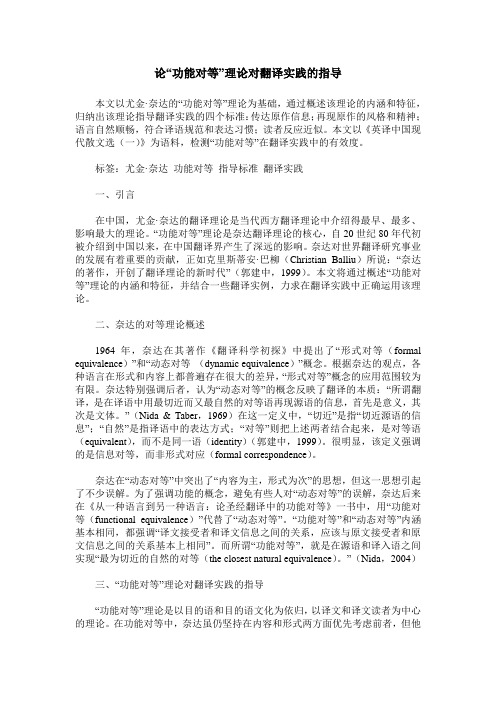
论“功能对等”理论对翻译实践的指导本文以尤金·奈达的“功能对等”理论为基础,通过概述该理论的内涵和特征,归纳出该理论指导翻译实践的四个标准:传达原作信息;再现原作的风格和精神;语言自然顺畅,符合译语规范和表达习惯;读者反应近似。
本文以《英译中国现代散文选(一)》为语料,检测“功能对等”在翻译实践中的有效度。
标签:尤金·奈达功能对等指导标准翻译实践一、引言在中国,尤金·奈达的翻译理论是当代西方翻译理论中介绍得最早、最多、影响最大的理论。
“功能对等”理论是奈达翻译理论的核心,自20世纪80年代初被介绍到中国以来,在中国翻译界产生了深远的影响。
奈达对世界翻译研究事业的发展有着重要的贡献,正如克里斯蒂安·巴柳(Christian Balliu)所说:“奈达的著作,开创了翻译理论的新时代”(郭建中,1999)。
本文将通过概述“功能对等”理论的内涵和特征,并结合一些翻译实例,力求在翻译实践中正确运用该理论。
二、奈达的对等理论概述1964年,奈达在其著作《翻译科学初探》中提出了“形式对等(formal equivalence)”和“动态对等(dynamic equivalence)”概念。
根据奈达的观点,各种语言在形式和内容上都普遍存在很大的差异,“形式对等”概念的应用范围较为有限。
奈达特别强调后者,认为“动态对等”的概念反映了翻译的本质:“所谓翻译,是在译语中用最切近而又最自然的对等语再现源语的信息,首先是意义,其次是文体。
”(Nida & Taber,1969)在这一定义中,“切近”是指“切近源语的信息”;“自然”是指译语中的表达方式;“对等”则把上述两者结合起来,是对等语(equivalent),而不是同一语(identity)(郭建中,1999)。
很明显,该定义强调的是信息对等,而非形式对应(formal correspondence)。
奈达在“动态对等”中突出了“内容为主,形式为次”的思想,但这一思想引起了不少误解。
功能对等理论在英语文本翻译中的应用
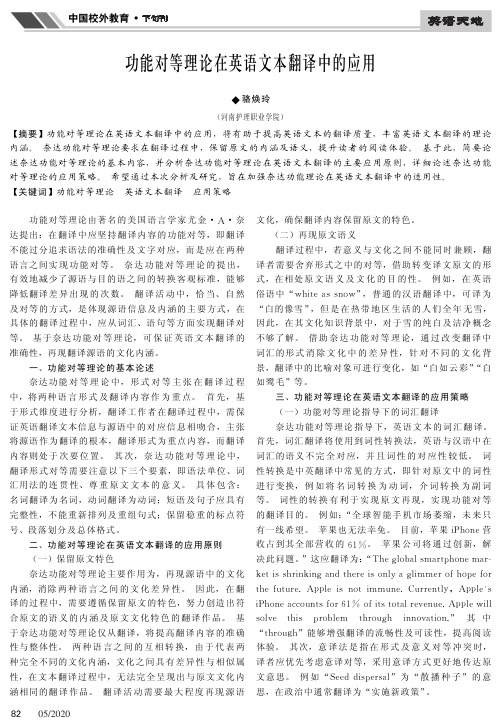
05/2020功能对等理论在英语文本翻译中的应用◆骆焕玲(河南护理职业学院)【摘要】功能对等理论在英语文本翻译中的应用,将有助于提高英语文本的翻译质量,丰富英语文本翻译的理论内涵。
奈达功能对等理论要求在翻译过程中,保留原文的内涵及语义,提升读者的阅读体验。
基于此,简要论述奈达功能对等理论的基本内容,并分析奈达功能对等理论在英语文本翻译的主要应用原则,详细论述奈达功能对等理论的应用策略。
希望通过本次分析及研究,旨在加强奈达功能理论在英语文本翻译中的适用性。
【关键词】功能对等理论英语文本翻译应用策略功能对等理论由著名的美国语言学家尤金·A ·奈达提出:在翻译中应坚持翻译内容的功能对等,即翻译不能过分追求语法的准确性及文字对应,而是应在两种语言之间实现功能对等。
奈达功能对等理论的提出,有效地减少了源语与目的语之间的转换客观标准,能够降低翻译差异出现的次数。
翻译活动中,恰当、自然及对等的方式,是体现源语信息及内涵的主要方式,在具体的翻译过程中,应从词汇、语句等方面实现翻译对等。
基于奈达功能对等理论,可保证英语文本翻译的准确性,再现翻译源语的文化内涵。
一、功能对等理论的基本论述奈达功能对等理论中,形式对等主张在翻译过程中,将两种语言形式及翻译内容作为重点。
首先,基于形式维度进行分析,翻译工作者在翻译过程中,需保证英语翻译文本信息与源语中的对应信息相吻合,主张将源语作为翻译的根本,翻译形式为重点内容,而翻译内容则处于次要位置。
其次,奈达功能对等理论中,翻译形式对等需要注意以下三个要素,即语法单位、词汇用法的连贯性、尊重原文文本的意义。
具体包含:名词翻译为名词,动词翻译为动词;短语及句子应具有完整性,不能重新排列及重组句式;保留稳重的标点符号、段落划分及总体格式。
二、功能对等理论在英语文本翻译的应用原则(一)保留原文特色奈达功能对等理论主要作用为,再现源语中的文化内涵,消除两种语言之间的文化差异性。
基于功能对等理论的科技英语翻译实践研究
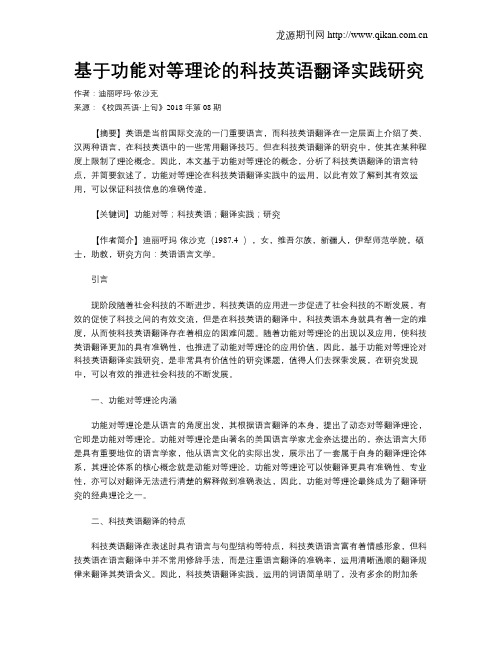
基于功能对等理论的科技英语翻译实践研究作者:迪丽呼玛·依沙克来源:《校园英语·上旬》2018年第08期【摘要】英语是当前国际交流的一门重要语言,而科技英语翻译在一定层面上介绍了英、汉两种语言,在科技英语中的一些常用翻译技巧。
但在科技英语翻译的研究中,使其在某种程度上限制了理论概念。
因此,本文基于功能对等理论的概念,分析了科技英语翻译的语言特点,并简要叙述了,功能对等理论在科技英语翻译实践中的运用,以此有效了解到其有效运用,可以保证科技信息的准确传递。
【关键词】功能对等;科技英语;翻译实践;研究【作者简介】迪丽呼玛·依沙克(1987.4- ),女,维吾尔族,新疆人,伊犁师范学院,硕士,助教,研究方向:英语语言文学。
引言现阶段随着社会科技的不断进步,科技英语的应用进一步促进了社会科技的不断发展,有效的促使了科技之间的有效交流,但是在科技英语的翻译中,科技英语本身就具有着一定的难度,从而使科技英语翻译存在着相应的困难问题。
随着功能对等理论的出现以及应用,使科技英语翻译更加的具有准确性,也推进了动能对等理论的应用价值,因此,基于功能对等理论对科技英语翻译实践研究,是非常具有价值性的研究课题,值得人们去探索发展,在研究发现中,可以有效的推进社会科技的不断发展。
一、功能对等理论内涵功能对等理论是从语言的角度出发,其根据语言翻译的本身,提出了动态对等翻译理论,它即是功能对等理论。
功能对等理论是由著名的美国语言学家尤金奈达提出的,奈达语言大师是具有重要地位的语言学家,他从语言文化的实际出发,展示出了一套属于自身的翻译理论体系,其理论体系的核心概念就是动能对等理论。
功能对等理论可以使翻译更具有准确性、专业性,亦可以对翻译无法进行清楚的解释做到准确表达,因此,功能对等理论最终成为了翻译研究的经典理论之一。
二、科技英语翻译的特点科技英语翻译在表述时具有语言与句型结构等特点,科技英语语言富有着情感形象,但科技英语在语言翻译中并不常用修辞手法,而是注重语言翻译的准确率,运用清晰通顺的翻译规律来翻译其英语含义。
功能对等理论指导下的学术英语翻译
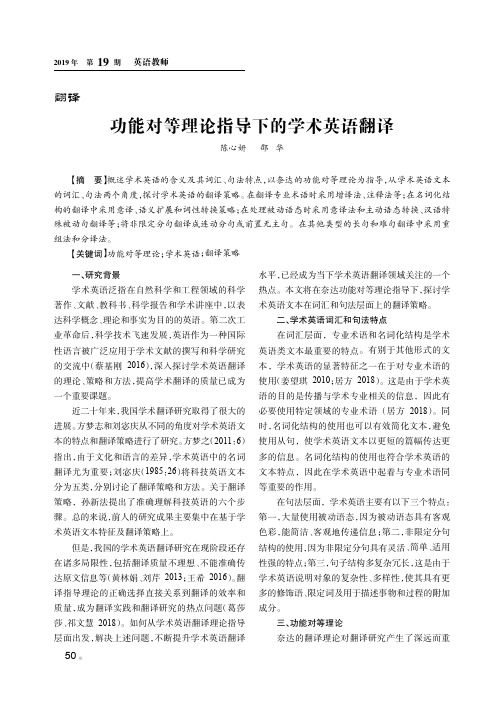
一、研究背景学术英语泛指在自然科学和工程领域的科学著作、文献、教科书、科学报告和学术讲座中,以表达科学概念、理论和事实为目的的英语。
第二次工业革命后,科学技术飞速发展,英语作为一种国际性语言被广泛应用于学术文献的撰写和科学研究的交流中(蔡基刚2016),深入探讨学术英语翻译的理论、策略和方法,提高学术翻译的质量已成为一个重要课题。
近二十年来,我国学术翻译研究取得了很大的进展。
方梦志和刘宓庆从不同的角度对学术英语文本的特点和翻译策略进行了研究。
方梦之(2011:6)指出,由于文化和语言的差异,学术英语中的名词翻译尤为重要;刘宓庆(1985:26)将科技英语文本分为五类,分别讨论了翻译策略和方法。
关于翻译策略,孙新法提出了准确理解科技英语的六个步骤。
总的来说,前人的研究成果主要集中在基于学术英语文本特征及翻译策略上。
但是,我国的学术英语翻译研究在现阶段还存在诸多局限性,包括翻译质量不理想、不能准确传达原文信息等(黄林娟、刘芹2013;王希2016)。
翻译指导理论的正确选择直接关系到翻译的效率和质量,成为翻译实践和翻译研究的热点问题(葛莎莎、祁文慧2018)。
如何从学术英语翻译理论指导层面出发,解决上述问题,不断提升学术英语翻译水平,已经成为当下学术英语翻译领域关注的一个热点。
本文将在奈达功能对等理论指导下,探讨学术英语文本在词汇和句法层面上的翻译策略。
二、学术英语词汇和句法特点在词汇层面,专业术语和名词化结构是学术英语类文本最重要的特点。
有别于其他形式的文本,学术英语的显著特征之一在于对专业术语的使用(姜望琪2010;居方2018)。
这是由于学术英语的目的是传播与学术专业相关的信息,因此有必要使用特定领域的专业术语(居方2018)。
同时,名词化结构的使用也可以有效简化文本,避免使用从句,使学术英语文本以更短的篇幅传达更多的信息。
名词化结构的使用也符合学术英语的文本特点,因此在学术英语中起着与专业术语同等重要的作用。
基于功能对等理论的科技英语翻译探讨
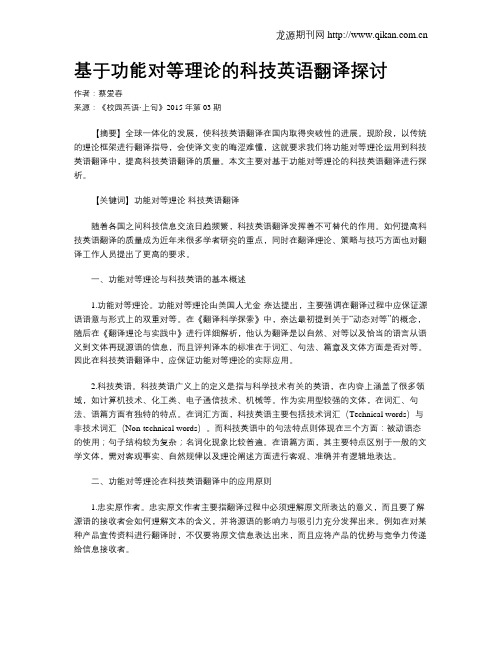
基于功能对等理论的科技英语翻译探讨作者:蔡爱春来源:《校园英语·上旬》2015年第03期【摘要】全球一体化的发展,使科技英语翻译在国内取得突破性的进展。
现阶段,以传统的理论框架进行翻译指导,会使译文变的晦涩难懂,这就要求我们将功能对等理论运用到科技英语翻译中,提高科技英语翻译的质量。
本文主要对基于功能对等理论的科技英语翻译进行探析。
【关键词】功能对等理论科技英语翻译随着各国之间科技信息交流日趋频繁,科技英语翻译发挥着不可替代的作用。
如何提高科技英语翻译的质量成为近年来很多学者研究的重点,同时在翻译理论、策略与技巧方面也对翻译工作人员提出了更高的要求。
一、功能对等理论与科技英语的基本概述1.功能对等理论。
功能对等理论由美国人尤金·奈达提出,主要强调在翻译过程中应保证源语语意与形式上的双重对等。
在《翻译科学探索》中,奈达最初提到关于“动态对等”的概念,随后在《翻译理论与实践中》进行详细解析,他认为翻译是以自然、对等以及恰当的语言从语义到文体再现源语的信息,而且评判译本的标准在于词汇、句法、篇章及文体方面是否对等。
因此在科技英语翻译中,应保证功能对等理论的实际应用。
2.科技英语。
科技英语广义上的定义是指与科学技术有关的英语,在内容上涵盖了很多领域,如计算机技术、化工类、电子通信技术、机械等。
作为实用型较强的文体,在词汇、句法、语篇方面有独特的特点。
在词汇方面,科技英语主要包括技术词汇(Technical words)与非技术词汇(Non-technical words)。
而科技英语中的句法特点则体现在三个方面:被动语态的使用;句子结构较为复杂;名词化现象比较普遍。
在语篇方面,其主要特点区别于一般的文学文体,需对客观事实、自然规律以及理论阐述方面进行客观、准确并有逻辑地表达。
二、功能对等理论在科技英语翻译中的应用原则1.忠实原作者。
忠实原文作者主要指翻译过程中必须理解原文所表达的意义,而且要了解源语的接收者会如何理解文本的含义,并将源语的影响力与吸引力充分发挥出来。
功能对等理论指导下的高校学生手册汉译研究
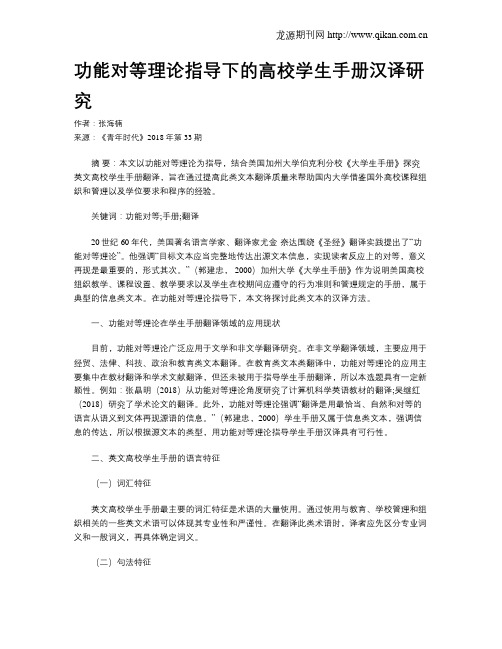
功能对等理论指导下的高校学生手册汉译研究作者:张海楠来源:《青年时代》2018年第33期摘要:本文以功能对等理论为指导,结合美国加州大学伯克利分校《大学生手册》探究英文高校学生手册翻译,旨在通过提高此类文本翻译质量来帮助国内大学借鉴国外高校课程组织和管理以及学位要求和程序的经验。
关键词:功能对等;手册;翻译20世纪60年代,美国著名语言学家、翻译家尤金·奈达围绕《圣经》翻译实践提出了“功能对等理论”。
他强调“目标文本应当完整地传达出源文本信息,实现读者反应上的对等,意义再现是最重要的,形式其次。
”(郭建忠, 2000)加州大学《大学生手册》作为说明美国高校组织教学、课程设置、教学要求以及学生在校期间应遵守的行为准则和管理规定的手册,属于典型的信息类文本。
在功能对等理论指导下,本文将探讨此类文本的汉译方法。
一、功能对等理论在学生手册翻译领域的应用现状目前,功能对等理论广泛应用于文学和非文学翻译研究。
在非文学翻译领域,主要应用于经贸、法律、科技、政治和教育类文本翻译。
在教育类文本类翻译中,功能对等理论的应用主要集中在教材翻译和学术文献翻译,但还未被用于指导学生手册翻译,所以本选题具有一定新颖性。
例如:张晶明(2018)从功能对等理论角度研究了计算机科学英语教材的翻译;吴继红(2018)研究了学术论文的翻译。
此外,功能对等理论强调“翻译是用最恰当、自然和对等的语言从语义到文体再现源语的信息。
”(郭建忠,2000)学生手册又属于信息类文本,强调信息的传达,所以根据源文本的类型,用功能对等理论指导学生手册汉译具有可行性。
二、英文高校学生手册的语言特征(一)词汇特征英文高校学生手册最主要的词汇特征是术语的大量使用。
通过使用与教育、学校管理和组织相关的一些英文术语可以体现其专业性和严谨性。
在翻译此类术语时,译者应先区分专业词义和一般词义,再具体确定词义。
(二)句法特征英文高校学生手册的句法特征主要体现在被动句、复合句和长难句的使用。
功能对等理论指导下的铆接工具说明书英译汉翻译报告
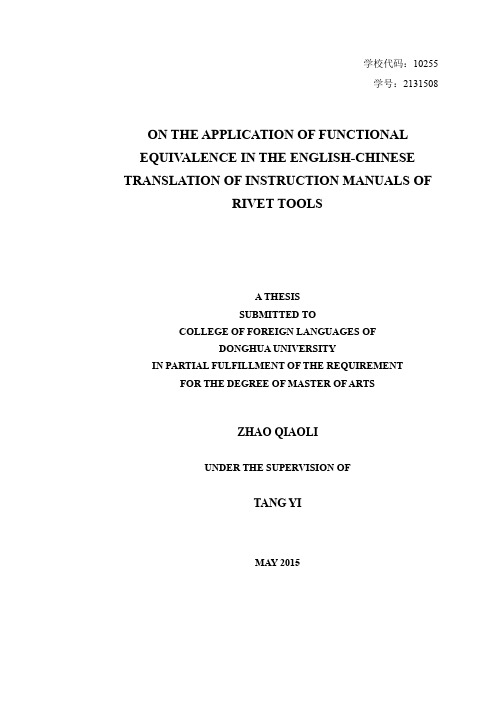
学校代码:10255学号:2131508ON THE APPLICATION OF FUNCTIONALEQUIV ALENCE IN THE ENGLISH-CHINESE TRANSLATION OF INSTRUCTION MANUALS OFRIVET TOOLSA THESISSUBMITTED TOCOLLEGE OF FOREIGN LANGUAGES OFDONGHUA UNIVERSITYIN PARTIAL FULFILLMENT OF THE REQUIREMENTFOR THE DEGREE OF MASTER OF ARTSZHAO QIAOLIUNDER THE SUPERVISION OFTANG YIMAY 2015致谢翻译硕士两年的学习生活即将结束,我将带着丰富的收获离开校园,走入社会和工作岗位。
感谢东华大学外语学院这个平台,让我遇到了教导有方、敬业爱生的各位任课老师,对我的学习、求职、生活关心备至的辅导员,以及一班可亲可爱的同学。
在与你们的交流中,我不仅得到了知识,也得到了珍贵的友谊,这将是伴我一生的财富。
在此我要特别感谢我的指导老师唐毅副教授。
她以渊博的学识、严谨的治学态度、丰富的人生阅历,指导着我在学业上不断上进,并在生活和求职中做好规划。
在开题答辩和此次翻译报告的撰写过程中,唐老师对我进行了反复的指导,对我的每一次修改稿严格把关,这是我能够顺利毕业的重要因素。
同时我也十分感谢我的家人,尤其是我的爱人。
在这两年的硕士生涯中,努力学习之余,我完成了结婚生子的人生大事。
家人的理解、支持和帮助,让我能够较好地在学业和家庭之间平衡兼顾。
最后我也要感谢为我提供翻译实习机会的上海乘鹰新材料有限公司,生产部门给了我大量的翻译材料,也在翻译过程中给予我指导,对翻译质量进行严格把关,这帮助我提高了翻译水平,也锻炼了在工作中与人交往的能力。
毕业意味着在学校的学习生涯暂告一段落,然“吾生也有涯,而知也无涯”,学习是永无止境的。
功能对等理论指导下科普文本的翻译

2、语法对等:学术英语通常具有特定的语法结构和表达方式。在翻译过程 中,译者应尽量保持源语的语法结构,以确保目标语读者能够理解和欣赏源语的 独特之处。
3、语用对等:在学术英语翻译中,语用对等强调的是翻译中上下文和语境 的考虑。译者需要理解源语中的文化背景和语境,并在目标语中寻找相应的表达 方式,以确保目标语读者能够理解和接受。
最后,在功能对等理论指导下的广告翻译策略,还需要语言问题。目标语言 要符合语法规范,避免出现语言漏洞或逻辑缺陷;目标语言要与原广告的语言特 点、文化内涵、受众需求相符合。此外,目标语言要有利于推动广告效果的转化, 增强受众的阅读兴趣和度。例如,可以使用简单易懂的语言来吸引消费者的注意 力,同时也可以使用具有感染力的词汇和修辞手法来增强广告的吸引力。
Translation:
The Andromeda Galaxy is the closest spiral galaxy to our own, with a distance of only 2.5 million light-years. Its name comes from the fact that it appears as a blurry blob to the naked eye, resembling an island in the sky. In fact, the Andromeda Galaxy is so large that it can be seen with the naked eye as a blurry blob in the c
参考内容
在翻译领域,尤其是诗歌翻译中,功能对等理论(Functional Equivalence) 具有极高的指导价值。这一理论强调,翻译的目标不仅仅是词汇或句法的对应, 而更应是功能的对应。在诗歌翻译中,这意味着不仅要传达原文的表面含义,还 需传达出原文的情感、意象、风格等更深层次的内容。
浅谈功能对等视角下的科技英语翻译
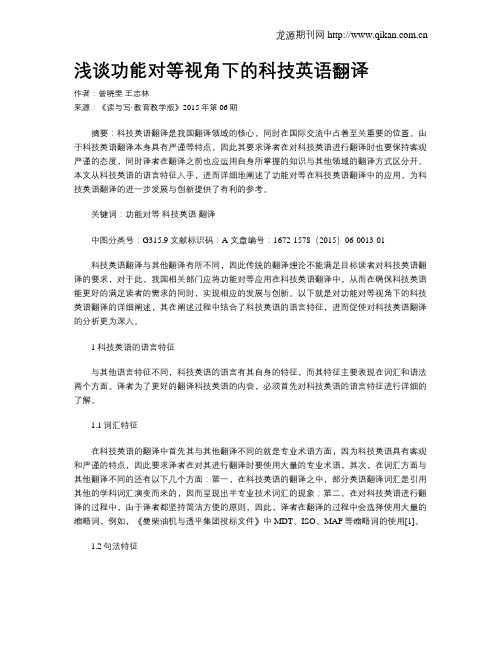
浅谈功能对等视角下的科技英语翻译作者:曾晓雯王志林来源:《读与写·教育教学版》2015年第06期摘要:科技英语翻译是我国翻译领域的核心,同时在国际交流中占着至关重要的位置。
由于科技英语翻译本身具有严谨等特点,因此其要求译者在对科技英语进行翻译时也要保持客观严谨的态度,同时译者在翻译之前也应运用自身所掌握的知识与其他领域的翻译方式区分开。
本文从科技英语的语言特征入手,进而详细地阐述了功能对等在科技英语翻译中的应用,为科技英语翻译的进一步发展与创新提供了有利的参考。
关键词:功能对等科技英语翻译中图分类号:G315.9 文献标识码:A 文章编号:1672-1578(2015)06-0013-01科技英语翻译与其他翻译有所不同,因此传统的翻译理论不能满足目标读者对科技英语翻译的要求,对于此,我国相关部门应将功能对等应用在科技英语翻译中,从而在确保科技英语能更好的满足读者的需求的同时,实现相应的发展与创新。
以下就是对功能对等视角下的科技英语翻译的详细阐述,其在阐述过程中结合了科技英语的语言特征,进而促使对科技英语翻译的分析更为深入。
1 科技英语的语言特征与其他语言特征不同,科技英语的语言有其自身的特征,而其特征主要表现在词汇和语法两个方面。
译者为了更好的翻译科技英语的内容,必须首先对科技英语的语言特征进行详细的了解。
1.1词汇特征在科技英语的翻译中首先其与其他翻译不同的就是专业术语方面,因为科技英语具有客观和严谨的特点,因此要求译者在对其进行翻译时要使用大量的专业术语,其次,在词汇方面与其他翻译不同的还有以下几个方面:第一,在科技英语的翻译之中,部分英语翻译词汇是引用其他的学科词汇演变而来的,因而呈现出半专业技术词汇的现象;第二,在对科技英语进行翻译的过程中,由于译者都坚持简洁方便的原则,因此,译者在翻译的过程中会选择使用大量的缩略词,例如,《曼柴油机与透平集团投标文件》中MDT、ISO、MAP等缩略词的使用[1]。
《坎特伯雷故事集》中的人文主义
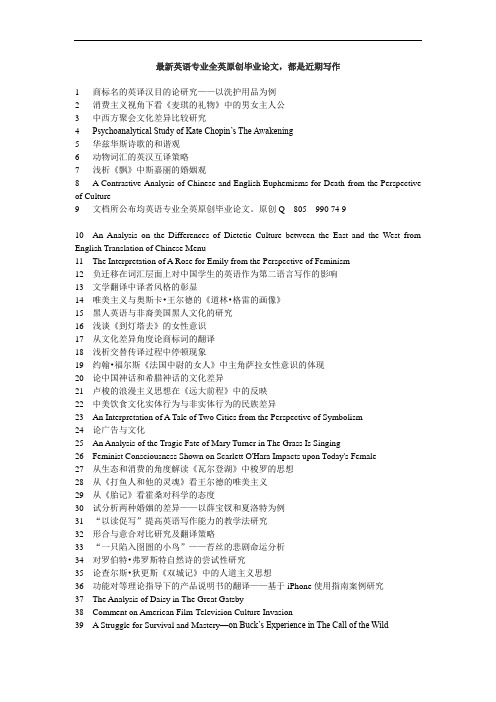
最新英语专业全英原创毕业论文,都是近期写作1 商标名的英译汉目的论研究——以洗护用品为例2 消费主义视角下看《麦琪的礼物》中的男女主人公3 中西方聚会文化差异比较研究4 Psychoanalytical Study of Kate Chopin’s The Awakening5 华兹华斯诗歌的和谐观6 动物词汇的英汉互译策略7 浅析《飘》中斯嘉丽的婚姻观8 A Contrastive Analysis of Chinese and English Euphemisms for Death from the Perspective of Culture9 文档所公布均英语专业全英原创毕业论文。
原创Q 805 990 74 910 An Analysis on the Differences of Dietetic Culture between the East and the West from English Translation of Chinese Menu11 The Interpretation of A Rose for Emily from the Perspective of Feminism12 负迁移在词汇层面上对中国学生的英语作为第二语言写作的影响13 文学翻译中译者风格的彰显14 唯美主义与奥斯卡•王尔德的《道林•格雷的画像》15 黑人英语与非裔美国黑人文化的研究16 浅谈《到灯塔去》的女性意识17 从文化差异角度论商标词的翻译18 浅析交替传译过程中停顿现象19 约翰•福尔斯《法国中尉的女人》中主角萨拉女性意识的体现20 论中国神话和希腊神话的文化差异21 卢梭的浪漫主义思想在《远大前程》中的反映22 中美饮食文化实体行为与非实体行为的民族差异23 An Interpretation of A Tale of Two Cities from the Perspective of Symbolism24 论广告与文化25 An Analysis of the Tragic Fate of Mary Turner in The Grass Is Singing26 Feminist Consciousness Shown on Scarlett O'Hara Impacts upon Today's Female27 从生态和消费的角度解读《瓦尔登湖》中梭罗的思想28 从《打鱼人和他的灵魂》看王尔德的唯美主义29 从《胎记》看霍桑对科学的态度30 试分析两种婚姻的差异——以薛宝钗和夏洛特为例31 “以读促写”提高英语写作能力的教学法研究32 形合与意合对比研究及翻译策略33 “一只陷入囹圄的小鸟”——苔丝的悲剧命运分析34 对罗伯特•弗罗斯特自然诗的尝试性研究35 论查尔斯•狄更斯《双城记》中的人道主义思想36 功能对等理论指导下的产品说明书的翻译——基于iPhone使用指南案例研究37 The Analysis of Daisy in The Great Gatsby38 Comment on American Film-Television Culture Invasion39 A Struggle for Survival and Mastery—on Buck’s Experience in The Call of the Wild40 艾米莉狄金森死亡诗歌的解读41 《雨中的猫》中女性主体意识的觉醒42 On the Non-observance of Cooperative Principle in English Advertising Language43 动物习语在英汉文化中的异同分析44 《哈利波特》系列小说的浪漫主义情节分析45 从概念隐喻看寓言的语篇连贯46 内向型与外向型性格对英语学习的影响47 从文化差异透视女性的不同命运—薛宝钗与韩美兰对比研究48 An Interpretation of Death in Jack London's Short Stories49 《小城畸人》里的象征主义手法分析50 重复在儿童英语教学中的重要性51 小说《飘》中瑞德巴特勒的人物性格分析52 形合与意合对比研究及翻译策略53 以《喜福会》中的母女关系为例试析跨文化交际中的“失语”现象54 《鲁滨逊漂流记》中殖民文化对殖民地文化影响解读55 The Elementary Stage Translation Teaching Design for Undergraduate English Majors56 A Comparison of the English Color Terms57 麦都思眼中的中国宗教形象58 论《红字》的模糊性59 中国英语初探60 哥特元素在《宠儿》中的运用61 中美幽默的比较62 On Chinese-English Translation of Public Signs: Problems and Suggested Solutions63 《红楼梦》两个英译本(杨译本和霍译本)诗词翻译对比赏析64 《嘉莉妹妹》中女主人公的服饰所反映的女性意识65 A Semantic Analysis of the Written Errors Committed by Chinese English Majors66 合作原则视角下探析广告语篇中省略的会话含意67 旅游翻译中的文化差异和处理策略68 视频辅助和背景知识对听力理解的作用69 中英颜色词内涵对比分析——《骆驼祥子》个案分析70 A Popular Form of Subtitles Translation by Fansub Group on the Internet71 试比较《汤姆索亚历险记》与《哈克贝利芬历险记》中主人公性格异同点72 从译者的读者意识看童话英汉翻译73 论英语新词对现代英语的影响74 从《阿甘正传》看美国青年文化75 从译者主体性视角探析《红楼梦》中概念隐喻的翻译策略76 从《消失的地平线》看儒家中庸之道的积极含义77 产品生命周期的营销策略78 Cultural Differences Between Chinese and American Social Etiquettes79 从心理学角度谈中国学生英语学习中典型语法错误的产生原因及其应对策略80 《水浒传》两个英译本中称谓语的翻译对比研究81 论初中英语教学中的情景创设82 《紫颜色》中爱丽斯沃克妇女主义解读83 与苦难嬉戏——透析《查尔斯兰姆散文集》84 《红字》中珠儿形象的象征主义分析85 从跨文化交际视角看幽默的言语机制和翻译86 对《一小时的故事》的批评分析87 目的论视角下新闻标题汉译英研究88 功能对等理论指导下的外贸函电翻译89 英汉基本姿势动词(立、坐、躺)的语义实证比较研究90 泰戈尔诗中自然物意象研究91 对跨文化交际中肢体语言的研究92 论《丽塔海华丝和肖申克救赎》中的反讽93 任璧莲《典型的美国佬》中的中国传统家庭观念的解体研究94 跨文化因素对字幕翻译的影响95 有关“生命”概念隐喻的英汉对比研究96 网络语料库对英语词汇学习的辅助作用初探97 英语电影片名翻译策略研究98 汤婷婷《女勇士》中的女性主义分析99 象征在表现主题方面的作用——分析爱伦坡的《一桶白葡萄酒》100 荒诞与抵抗——《局外人》中莫尔索的荒诞表现之原因分析101 艺术与现实之间的冲突--解读毛姆的《月亮和六便士》102 文类、历史与受众心态——论小说《红字》的电影改编103 从功能派目的论角度看商品说明书的英汉翻译104 Using Maslow’s Hierarchy Needs Theory to Analyze Sister Carrie’s Destiny105 精神之光——《到灯塔去》中拉姆齐夫人的人性解析106 埃德加爱伦坡的文学理论在《厄谢府倒塌》中的应用107 Domestication and Foreignization in the English-Chinese Translation--A Case Study of Two Chinese Versions of OHenry’s The Cop and the Anthem108 任务教学法在英语阅读教学中的应用109 目的论视角下英语电影片名的翻译110 浅谈《竞选州长》中的幽默与讽刺111 中国英语学习者道歉言语行为的中介语石化现象112 从《简•爱》与《藻海无边》看女性话语权的缺失113 论《儿子与情人》中的恋母情结114 从唯美主义的角度论《道林.格蕾的画像》中的主要人物115 毕业论文]比较《荆棘鸟》和《金锁记》小说中女性婚姻爱情悲剧原因116 《红色英勇勋章》主人公亨利•弗莱明心路历程探析117 论英汉数字习语的差异及翻译118 A Comparative Study of American and Chinese Spatial Language in Business Negotiation 119 浅析Gossip Girl中禁忌语的一般功能120 宗教枷锁下的人性挣扎——《红字》中丁梅斯代尔形象解读121 新闻英语文体分析122 A Comparison of the English Color Terms123 凯瑟琳•曼斯菲尔德《幸福》中的女性主义解读124 不一样的颤栗—东西方恐怖片的比较125 《简爱》中的人文主义思想述评126 The Comparison of Table Manners between China and Western Countries127 从电影《姐姐的守护者》分析人的自私性128 Cultural Influences on Business Negotiation between China and Japan129 《雾都孤儿》中批判现实主义写作手法分析130 诠释《儿子与情人》中儿子、母亲、情人之间的关系131 英语新闻的用词和翻译132 Charlotte Bronte’s Concept of Marriage--Comment on Jane Eyre from angle of true love 133 从中西文化差异看英汉数字翻译134 简析比喻在《围城》中的运用135 英文电影片名汉译策略研究136 从汉英墓志铭看中西生命价值意识之差异137 跨文化交际中的体态语138 浅析哈代主要小说作品中鸟的意象139 中医在英语世界的翻译与传播:过去与现在140 探析《愤怒的葡萄》中人性的力量141 论“and”的用法和翻译142 佩克拉的忧伤--解读《最蓝的眼睛》143 爱米丽与曹七巧悲剧性的弗洛伊德解读144 A Comparative Study of “Two Roses”in Wuthering Heights--Catherine Earnshaw and Catherine Linton145 《黑暗之心》的人性探究146 跨文化交际中的禁忌习俗147 浅析美国嘻哈文化影响下的美国俚语148 简奥斯丁的女权主义在《理智与情感》中的体现149 英语外贸信函的特点及翻译150 委婉语的适用性原则和策略151 欲望与死亡——对马丁伊登的精神分析152 中英手机短信的修辞特点分析153 从女权主义视角解读《简爱》154 《德伯家的苔丝》中的意象分析155 Approaching English V ocabulary Teaching—a Lexicological Perspective156 显现的被动•隐现的自我——《看不见的人》中被动语态的身份建构功能研究157 从《中国老人在曼哈顿》看中美人际关系差异158 作家的病态心理对文学创作的影响159 On the Female Initiation Theme in Little Women160 模因论指导下的英语习语汉译161 商务英语交流中委婉语的语用功能研究162 商标翻译及商标翻译中的文化禁忌163 浅析中西饮食文化差异及中餐菜名英译164 The Application of Corpus in Teaching Oral English165 广告翻译中的模因传播166 Study on the Basic Principles of Legal English Translation167 论网络英语的特征168 中医在英语世界的翻译与传播:过去与现在169 On the Importance of China English as an English Variant170 中西服饰文化差异对语言的影响171 从构式视野下对英语图式习语的解读172 美国电影中的大众文化价值观研究173 伍尔芙的人生经历对其小说创作的影响174 Biblical Ideas on Women and Sex175 古诗词英译关于夸张的翻译策略研究176 The Transcultural Differences in the Translation of Commercial Advertisements 177 跨文化视角下中西方选秀文化对比研究——以达人秀为例178 《道连葛雷的画像》叙事艺术的分析179 苔丝悲剧的解读180 英语幽默语的语用研究181 An Insight into Cause for Feminine Tragedy--A Case Study of A Rose for Emily 182 《小妇人》的女性意识解读183 奥斯卡.王尔德的美学观点及其在《道连格雷的画像》中的体现184 从违反合作原则研究《生活大爆炸》185 The Symbolic Meanings of Colours in The Great Gatsby186 A Probe into the Spiritual Worlds of The Old Man and the Sea187 功能文体学视角下的商务合同文体分析及翻译188 浅析情景教学法对初中英语课堂教学的影响189 中美文化中面子理论的对比分析190 电影《暮色》中人物对白的言语行为分析191 文化差异对中西方商务谈判的影响192 浅析《老人与海》中的悲剧色彩193 网络流行语翻译评析——“神马都是浮云”个案分析194 英汉“拉”类动词的语义成分和词化模式的对比分析195 新经济原则在商品买卖会话中的运用196 英语电影片名的翻译策略与方法197 报刊英语新词的汉译198 从“三美”原则看《荷塘月色》的翻译199 从汉英动物词汇的文化内涵看中西方文化差异200 从关联理论角度分析《绝望主妇》中话语标记语I mean。
- 1、下载文档前请自行甄别文档内容的完整性,平台不提供额外的编辑、内容补充、找答案等附加服务。
- 2、"仅部分预览"的文档,不可在线预览部分如存在完整性等问题,可反馈申请退款(可完整预览的文档不适用该条件!)。
- 3、如文档侵犯您的权益,请联系客服反馈,我们会尽快为您处理(人工客服工作时间:9:00-18:30)。
最新英语专业全英原创毕业论文,都是近期写作1 论约翰•多恩诗歌中的张力2 战争、归乡、爱情—《冷山》的多元主题研究3 中西文化差异在家庭教育中的体现4 身势语在演讲中的重要性和运用研究5 汉英动物词的文化内涵对比及翻译6 从简爱和安娜卡列尼娜的不同命运看女性意识的觉醒7 浅析初中生英语写作问题及对策8 商标翻译的方法及其影响因素9 威廉•福克纳小说中的女性形象分析--以《献给艾米丽的一朵玫瑰花》和《夕阳》为例10 傲慢与偏见的电影与原著比较11 On the Translation of Psychological Description in Wuthering Heights from the Perspective of Functional Equivalence12 文档所公布均英语专业全英原创毕业论文。
原创Q 799 75 79 3813 从文化视角浅谈旅游英语翻译14 从《推销员之死》看消费主义时代美国梦的破灭15 如何有效地扩展大学生英语词汇16 莎士比亚悲剧人物的海明威式英雄特征——以《哈姆雷特》与《奥赛罗》为例17 对《老人与海》中主人公的性格分析18 英语国家姓氏文化研究19 浅析王尔德《快乐王子》中基督教救赎的表现形式20 荒诞与抵抗——《局外人》中莫尔索的荒诞表现之原因分析21 从英汉思维模式差异看法律条文英译汉22 哈代的女性观在苔丝中的反映23 论《进入黑夜的漫长旅程》的悲剧成因24 Gone with the Wind: From Novel to Film25 师生关系与学生英语学习积极性之关联性探析26 中西方生死观之比较27 宗教禁欲下的爱情-论霍桑的宗教观与道德观在《红字》中的体现28 关联理论关照下文化缺省现象及其翻译应对策略29 论英语新词对现代英语的影响30 从数字看中西方文化差异31 古诗词英译关于夸张的翻译策略研究32 商业意识对美国电影片名翻译的影响33 功能对等与商务信函翻译34 从新历史主义视角解读杰罗姆•大卫•塞林格《麦田里的守望者》35 战后美国对伊拉克娱乐文化的影响36 从《老人与海》看海明威的硬汉精神37 Verification of Soft Term in Letter of Credit38 Sister Carrie—A Woman Lost in the Material World39 A Study of Hawthorne’s Criticism on Puritanism in The Scarlet Letter40 我国高中生英语学习动机研究41 浅析礼貌原则在跨文化交际中的体现42 Rhetorical Art and Chinese-English Translation Suggestions of Business Transaction Correspondence43 挣扎与妥协——浅析达洛维夫人的内心矛盾44 探究中学生厌倦学习英语45 对抗还是和谐——论《白鲸》人与自然的关系46 如何激发和培养初中生学习英语的兴趣47 论密西西比河对马克•吐温和《哈克贝利•费恩历险记》的影响48 论《哈克贝利费恩历险记》中的对比及效果49 米兰•昆德拉《不能承受的生命之轻》小说与电影版本的差异分析50 从产品说明书的英译错误分析探讨其翻译策略51 对《魂断蓝桥》女主角悲惨性命运原因的分析52 功能对等理论指导下的外贸函电翻译53 论小说《苔丝》中环境描写的作用54 浅析李尔王的陷落55 论翻译单位56 论《最后的莫西干人》中的印第安情结57 《罗密欧与朱丽叶》中双关语的研究58 从影片《刮痧》分析中美文化差异和冲突59 传播学视角下的影视字幕翻译研究—以美剧《复仇》为例60 阿瑟·米勒《推销员之死》中小人物的悲剧之源61 英汉日常礼貌用语在跨文化交际中的语用差异62 从好莱坞电影中的中国元素看美国对中国意识观念的转变63 剖析《所罗门之歌》中的黑人意识64 英语中的汉语借词65 中英广告中的双关语探析66 从目的论看儿童文学翻译--兼评《小王子》中英译本67 英汉“走类”动词短语概念隐喻的对比研究68 从《阿甘正传》看美国乐观主义69 Approaching English V ocabulary Teaching—a Lexicological Perspective70 《觉醒》中的爱与死亡71 A Comparative Study of “Two Roses”in Wuthering Heights--Catherine Earnshaw and Catherine Linton72 论托尼莫里森《宠儿》的哥特式元素73 商务电子邮件中礼貌用语的运用74 Analysis of the Female Characters in Oliver Twist75 从接受美学的角度研究电影名字的翻译76 从文化角度浅析新闻英语的翻译77 Where Should Gone With the Wind Go?——Study on The Disputes Among Critics of Gone With the Wind78 从中西方文化的比较中谈英语隐喻的汉译79 Whose Portrait Is This—Exploring Oscar Wilde’s Com plex Personality80 英文商标名翻译的原则与策略81 浅析《德伯维尔家的苔丝》中造成苔丝悲剧的因素82 英汉基本颜色词文化内涵之对比研究83 英语委婉语在英语教学中的应用84 商务英语交流中委婉语的语用功能研究85 浅析肯德基在中国的本土化策略86 英语课堂中的口语纠错策略87 On the Application of Polysystem Theory In the Two Versions of Hamlet88 从宝洁公司的运营模式看美国文化的多样性89 The Interpretation to Captain Ahab in Moby Dick through Abnormal Psychology90 菲茨杰拉德《了不起的盖茨比》中黛西的形象91 通过会话原则分析手机短信语言92 论《儿子与情人》中的恋母情结93 女性人格的双重性——从心理学的角度对比分析凯瑟琳和简爱94 从语言表达看中西思维方式差异95 外贸英文函电中委婉语的特点及应用研究96 奴隶制下的压迫与爱——浅析托尼•莫里森的《宠儿》97 论《大卫科波菲尔》中人物个性与时代背景的关系98 会话含义在商务谈判中的运用99 美国情景喜剧《成长的烦恼》中言语幽默解析100 透过《丛林》看美国梦的破灭101 Cause Analysis of Pragmatic Failure in Cross-cultural Communication102 外语教学中的折中主义思想研究103 A Comparison between Tess and Hester’s Tragic Destiny104 小议非英语专业大学生英语口语能力的培养105 以学生为主体的教学在初中英语写作教学中的应用106 Hardy’s View of feminism from Sue Bridehead in Jude the Obscure107 The Influences of the Bible on Some American Movies108 A Discussion of the Cultural Conflicts and the Integration in the Mother-Daughter Relationships in THE JOY LUCK CLUB109 A Comparative Study of Female Consciousness between Wang Anyi’s Everlasting Regret and Virgina Woolf’s Mrs. Dalloway110 Cultivation of Students’ Autonomy in Listening in Junior High School111 姓名—透视社会文化的窗口112 中英社交禁忌习俗异同之比较分析113 主位推进模式在语篇翻译中的应用114 The Determining Influence of Environment on the Development of Heathcliff’s Character 115 中西方空间观对比研究116 浅析《了不起的盖茨比》中的主要人物性格117 侠客精神和骑士精神折射出的文化差异—《七侠五义》和《亚瑟王之死》之比较118 从美国刑侦剧《犯罪现场调查》看讯问过程中合作原则的违反119 从电影《刮痧》看中西文化冲突120 从礼貌原则看《威尔与格蕾丝》的对话121 从《阿Q正传》译本看民族文化的可译性122 Pursuing a Harmonious Man-Woman Relationship In The Thorn Birds123 A Comparison of the English Color Terms124 《呼啸山庄》的哥特式传统125 英汉称谓的文化差异研究126 论女性主义对翻译标准的影响127 大学英语电影教学现状及对策分析128 透过《傲慢与偏见》看现代社会爱情观129 简•奥斯汀《曼斯菲尔德庄园》中女性角色的地位分析130 论《教授的房子》中圣彼得教授对自我的追求131 A Comparison of the English Color Terms132 从美狄亚和伊阿宋的故事探究希腊悲剧的复仇情节133 论《简爱》对当代女性爱情观的启示134 谈双关语的翻译135 《呼啸山庄》男主人公希斯克里夫的性格分析136 《警察与赞美诗》和《重新做人》中主人公的不同命运137 卡森•麦卡勒斯《心是孤独的猎手》福柯式解读138 语用学理论在经贸英语口译中的应用139 人性的堕落——解析《蝇王》人性恶的主题140 政论文的英译特点141 A Comparison of the English Color Terms142 爱情的悲歌-《荆棘鸟》悲剧成因探悉143 论高中英语写作教学中的文化意识培养144 跨文化交际背景下英语禁忌语探析145 从概念整合视角解读《老友记》中的言语幽默146 从功能对等理论看《生活大爆炸》中幽默字幕的汉译147 从小说《百万英镑》中看对当今社会的讽刺意义148 英语委婉语及其翻译149 做最好的自己—论斯佳丽形象对现代女性的教育意义150 网络语料库对英语词汇学习的辅助作用初探151 中国文化特色词汇的音译与中国文化的传播152 简析诚信在对外贸易中的作用153 语境顺应视角下英语情景喜剧中幽默字幕翻译--以《生活大爆炸》为例154 以马斯洛需求层次理论分析《傲慢与偏见》中的爱情婚姻观155 美国牛仔和牛仔文化156 翻译中的字词选择157 论托妮莫里森《最蓝的眼睛》中的母女关系158 平衡的维系——《天钧》中的道家思想159 英汉委婉语中体现的文化异同160 《麦田里的守望者》中霍尔顿的精神之旅161 A Comparison of the English Color Terms162 解析《飘》中斯嘉丽的女性主义思想在其婚姻中的体现163 英汉拒绝言语行为表达方式比较164 论《呼啸山庄》中的意象165 从《嘉莉妹妹》看美国梦与道德观166 文化视角下的英汉委婉语翻译探讨167 美国犹太文化与传统犹太文化的冲突——浅析《再见吧,哥伦布》168 美国总统就职演说中隐喻的语用功能分析169 英汉诗歌中“月”意象的认知解读170 哥特小说中的反天主教分析:《隐士》个案研究171 中英新闻标题的差异及翻译方法172 试论英语词汇教学中的词块教学173 英语复合名词的认知语义研究174 用隐喻理论分析英汉商标的语言特色175 国际商务英语信函写作中的礼貌策略176 论《了不起的盖茨比》中的道德观177 双关语在日常生活中的应用178 浅析导游词的翻译策略179 从女性主义视角分析《纯真年代》中两位女主人公的不同爱情观180 《诗经》中修饰性叠词的比较研究181 英汉致使事件词汇化模式对比研究182 对《斯佳丽》中生态女权主义的解读183 浅析信息时代的汉语新词语英译策略184 荣格原型理论下的多丽丝•莱辛《天黑前的夏天》185 浅析眼神交流在非语言交际中的作用186 当代中美青年恭维言语行为对比研究187 商务交际中you-attitude的语用功能探讨188 试析《汤姆叔叔的小屋》中两个奴隶的性格和命运189 狄更斯《双城记》中的人道主义思想190 《罗密欧与朱丽叶》与《梁祝》结局的文化对比研究191 简爱性格魅力分析192 情景教学法在初中英语词汇教学中的应用193 商务谈判中幽默语的运用194 基于微博(推特)文化的新型营销模式195 传统道德与时代新意识之战―论林语堂在《京华烟云》中的婚恋观196 网络流行语翻译评析——“神马都是浮云”个案分析197 浅析美国高等教育的创新198 《简爱》和《吕贝卡》中女权意识的对比199 高中英语反思式教学研究200 《麦克白》的独白。
